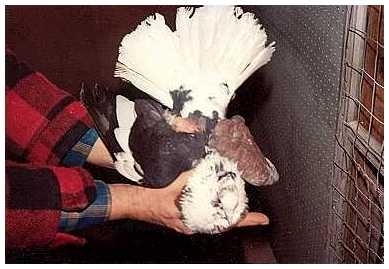mosaicF.jpg
MOSAIC

MOSAICS--PATCHWORK PIGEONS Not much has been printed about the why and
wherefore of the strangest mark in all of pigeondorn, the Mosaic.
I asked one of the finest geneticist in the country to explain this
phenomenon to the Internet pigeon surfers. I have included a
photograph of a Mosaic for your enlightenment. So, without ftuther ado,
here's the lowdown on Mosaics from Tim Kvidera. The term "Mosaic" is
used to describe the appearance of two mutually exclusive expressions
showing up on the same bird. This typically involves two different
colors, or patterns, or both, being expressed in different areas of
the bird. But it can also occur with differing feather structure, etc.
sometime it will result in one side of the bird looking like one
thing while the opposite side looks different, but more often the
differences are splotched randomly on the bird. For example a blue bar
on one wing and blue check on the other. Or more complicated, a hen
that is blue bar on one side and an ash red dilute(cream) bar on the
other. Both ash red and wild type (blue) are sex-linked genes. Hens
have only one chromosome. So how can a hen be both blue and cream?
The actual mechanism for creation of Mosaics is not totality under
stood. there may be more then one way that they can happen. Currently
one of the more accepted theories is that of "bipatemity". This concept
was first put forward by Dr. Willard F. Hollander. It basically says
that multiple sperms are responsible for the bird. One sperm actually
fertilized the egg, but others got there too. Some of them stuck to the
fertilized ovutngot grafted into the developing embryo, and were able
to replicate themselves into the Mosaic patches. These competing sperm
can be from different cock birds, or from one who is heterozygous for
the expressed traits. There has been an observed tendency for Mosaic
birds to breed as though they are genetically the color that is
expressed on their rump, the area directly above their sex organs.
It is rare that a Mosaic will produce a Mosaic. But there appears to be
instances where some families of a breed may be more prone to
production of Mosaics than others. ( Tim Kvidera, 1999)
